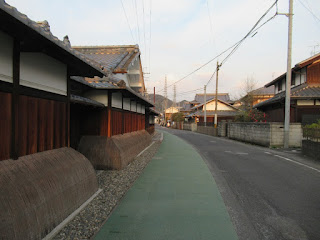I started today’s walk from Gokasho, about three kilimeters southwest from Echigawa shukuba station. A village developed along Nakasendo in the Edo era. Gokasho is now in Higashiomi City.
Gokasho is famous as it produced many famous merchants.
Old merchants’ houses remain along Nakasendo.
Houses with straw‐thatched roofs also remain.
There stands a statue of a merchant at the southwest side of Gokasho. He carries a pole on his shoulder. It is a typical appearance of the Edo period’s merchant. (See also the top photo)
I continued walking and moved into Omihachiman city. There are houses, agricultural fields as well as factories along Nakasendo. Cherry blossom was beautiful in many places.
I arrived Musa, the 67th station from Tokyo. It is in Omihachiman City. This place also produced famous merchants.
Some parts – the main gate and walls -- of the main
guest house (honjin) as well as other traditional buildings remain here.
Wheat fields spread along Nakasendo. I found Shinkansen bullet train running over the field. (see the 2nd photo)
I passed the Hino River and enjoyed the cherry blossom on the riverbanks.
I moved in Ryuo Town. There are many spots relating to Minamoto Yoshitsune, a tragic hero in the late 11th century. He had his coming-of-age ceremony in Kagami Shrine and neighboring places.
He killed the last leaders of Heike family, the rival of Yoshitsune’s family Genji, in the place.
Nakasendo is converted into National Route 8 in some places. There are many big factories along National Route 8.
I finished today’s walk at Yasu City. It is about three km before Moriyama, the 67th shukuba station.















No comments:
Post a Comment